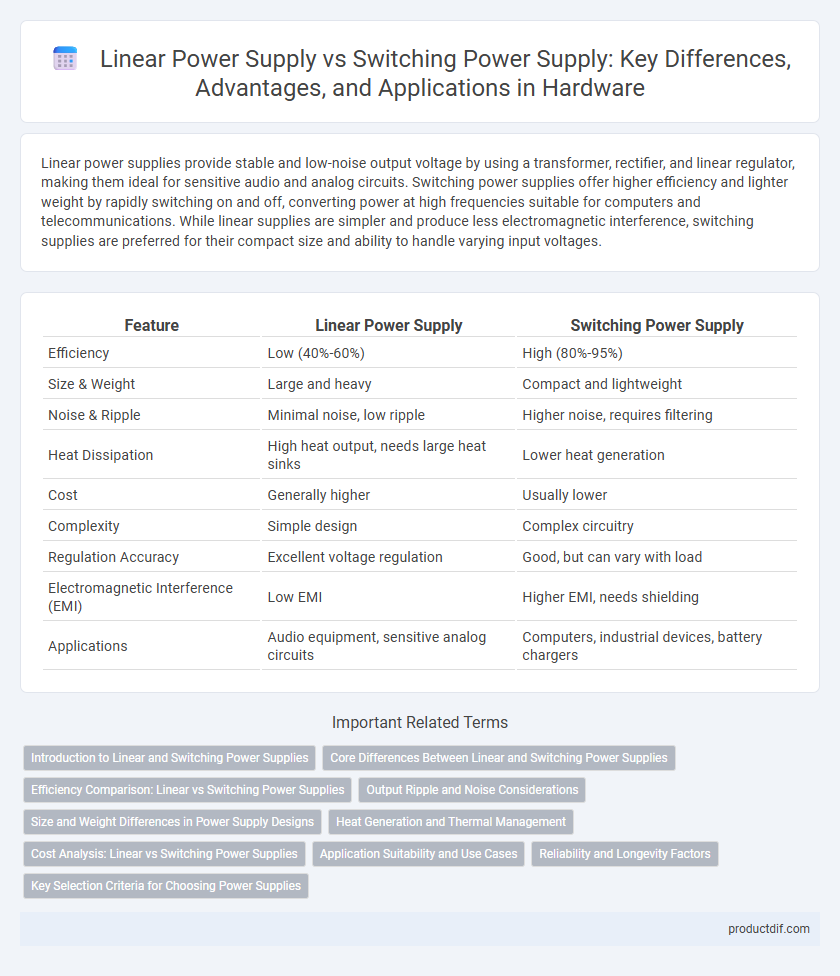Linear power supplies provide stable and low-noise output voltage by using a transformer, rectifier, and linear regulator, making them ideal for sensitive audio and analog circuits. Switching power supplies offer higher efficiency and lighter weight by rapidly switching on and off, converting power at high frequencies suitable for computers and telecommunications. While linear supplies are simpler and produce less electromagnetic interference, switching supplies are preferred for their compact size and ability to handle varying input voltages.
Table of Comparison
| Feature | Linear Power Supply | Switching Power Supply |
|---|---|---|
| Efficiency | Low (40%-60%) | High (80%-95%) |
| Size & Weight | Large and heavy | Compact and lightweight |
| Noise & Ripple | Minimal noise, low ripple | Higher noise, requires filtering |
| Heat Dissipation | High heat output, needs large heat sinks | Lower heat generation |
| Cost | Generally higher | Usually lower |
| Complexity | Simple design | Complex circuitry |
| Regulation Accuracy | Excellent voltage regulation | Good, but can vary with load |
| Electromagnetic Interference (EMI) | Low EMI | Higher EMI, needs shielding |
| Applications | Audio equipment, sensitive analog circuits | Computers, industrial devices, battery chargers |
Introduction to Linear and Switching Power Supplies
Linear power supplies regulate voltage using a linear regulator, providing low noise and stable output ideal for sensitive analog circuits. Switching power supplies convert electrical power using high-frequency switching components, offering higher efficiency, compact size, and better thermal management. Both types serve distinct applications based on performance, efficiency, and complexity requirements.
Core Differences Between Linear and Switching Power Supplies
Linear power supplies regulate output voltage using a linear regulator, resulting in low noise and excellent voltage precision but lower efficiency and higher heat dissipation. Switching power supplies convert electrical power using high-frequency switching components, offering higher efficiency, smaller size, and lighter weight, though they may introduce electrical noise and require complex filtering. Core differences revolve around efficiency, size, heat generation, noise levels, and complexity of design, impacting their suitability for various electronic applications.
Efficiency Comparison: Linear vs Switching Power Supplies
Switching power supplies achieve efficiency rates of 80% to 90% by utilizing high-frequency switching and energy storage components, minimizing power loss during voltage conversion. Linear power supplies typically operate at 40% to 60% efficiency due to continuous voltage regulation through dissipative elements like resistors and transistors. Higher efficiency in switching power supplies leads to less heat generation and lower energy consumption, making them preferable for applications requiring energy conservation and compact size.
Output Ripple and Noise Considerations
Linear power supplies exhibit significantly lower output ripple and noise due to their simple regulation mechanism, making them ideal for sensitive analog and audio applications. Switching power supplies, while more efficient and compact, generate higher output ripple and electromagnetic interference, requiring additional filtering components to minimize noise. Careful design and component selection in switching supplies can reduce ripple, but linear supplies inherently provide cleaner output voltage.
Size and Weight Differences in Power Supply Designs
Linear power supplies are typically larger and heavier due to bulky transformers and extensive heat sinks required for voltage regulation and dissipation. Switching power supplies utilize high-frequency transformers and smaller components, resulting in significantly reduced size and weight while maintaining efficiency. These design differences make switching power supplies more suitable for compact and portable electronic devices.
Heat Generation and Thermal Management
Linear power supplies generate more heat due to their voltage regulation method, which dissipates excess energy as heat, necessitating larger heat sinks and effective thermal management solutions. Switching power supplies operate at higher efficiency, producing significantly less heat and reducing the need for bulky cooling components, allowing for more compact designs. Effective thermal management in linear supplies involves maintaining airflow and heat dissipation surfaces, while switching supplies rely heavily on proper PCB layout and component selection to minimize thermal stress.
Cost Analysis: Linear vs Switching Power Supplies
Linear power supplies typically incur higher manufacturing costs due to larger transformers and heat dissipation components, resulting in less efficiency and increased energy expenses. Switching power supplies offer superior cost efficiency through compact design, reduced material use, and higher power conversion efficiency, lowering operational and cooling costs. The initial investment in switching power supplies may be higher, but overall lifecycle costs tend to be lower compared to linear power supply systems.
Application Suitability and Use Cases
Linear power supplies deliver clean, low-noise DC output ideal for sensitive audio equipment, laboratory instruments, and precise analog circuits where minimal electromagnetic interference is critical. Switching power supplies offer high efficiency and compact size, making them suitable for computers, telecommunications, and portable devices requiring efficient energy conversion and heat management. Applications with strict noise constraints favor linear supplies, whereas space- or weight-sensitive environments benefit from switching power supplies.
Reliability and Longevity Factors
Linear power supplies feature fewer components and generate less electromagnetic interference, contributing to higher reliability and longer lifespan in stable environments. Switching power supplies operate at higher frequencies with increased efficiency but involve complex circuitry prone to more wear and potential failures over time. Thermal management in linear designs typically results in lower operating temperatures, enhancing device longevity compared to the variable thermal stresses in switching power supplies.
Key Selection Criteria for Choosing Power Supplies
Linear power supplies offer low noise and simple design, making them ideal for sensitive analog circuits requiring stable voltage and minimal electromagnetic interference. Switching power supplies provide higher efficiency, smaller size, and better thermal performance, suitable for applications demanding power savings and compact form factors. Key selection criteria include load regulation, efficiency, noise tolerance, thermal management, and cost relative to the intended application's sensitivity and space constraints.
Linear power supply vs Switching power supply Infographic

 productdif.com
productdif.com